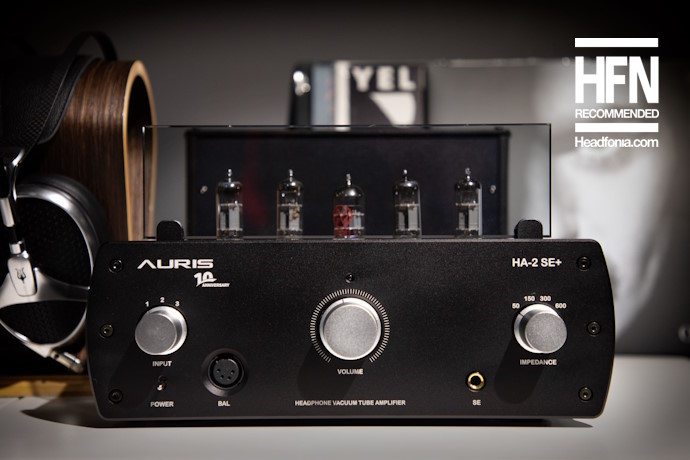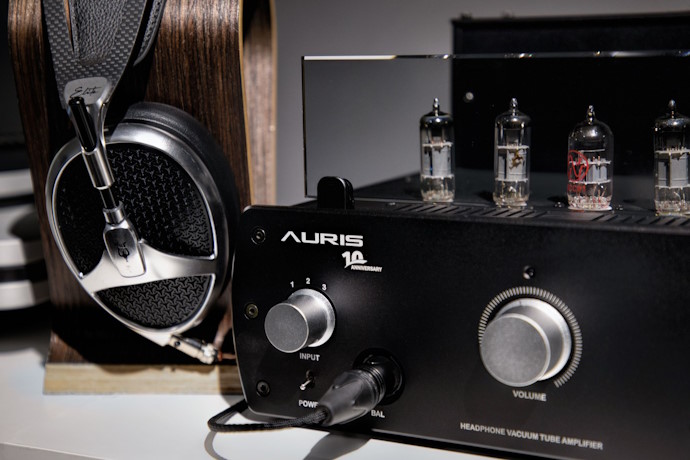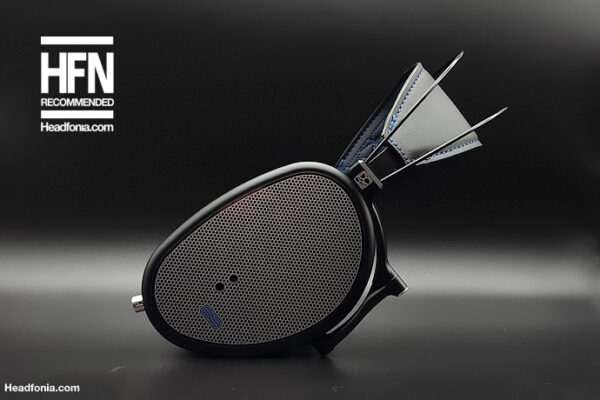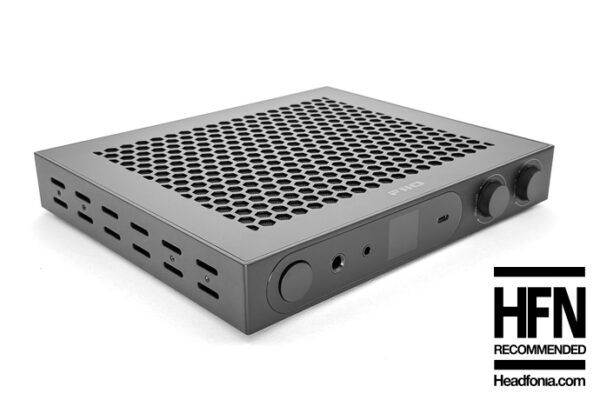Amplifier layout
The front panel features an On/Off Switch, Input Line Selector, and a 4-pin XLR balanced output on the left. The volume control takes the center stage, while the 6.3mm single-ended headphone output is conveniently positioned next to it. On the far right side, you’ll find the impedance selector, allowing you to optimize performance for headphones with impedance options of 50/150/300/600 Ohms. The Auris 10y anniversary label is in the top left of the front plate, the HA2-SE+ product name is in the top right corner.
The top of the unit showcases the five tubes (4 x PL95 and 1 x ECC81), which serve as a centerpiece of the design. These tubes are protected by a stylish glass “plate“, separating them from the control section. Turning to the rear of the unit, you’ll find the XLR and two RCA inputs, along with the Pre Output on the left. In the middle you have the RCA pre output. The EL95 or PL95 selector switch is positioned right next to it. On the right side, you’ll find the Input voltage selector, power cord Inlet, and the main On/Off Switch.
The Amplifier is very easy to work with and there’s enough room on the back to easily connect and disconnect your cables. You can also easily use fancy aftermarket cables with larger sized connectors, that’s no issue at all.
Specs
Tubes: 1 x ECC81, 4 x PL95 (or EL95)
Tube Selection : Manual Switch
Input Sensitivity: 1 Vrms
Input Impedance: 470 k
Power Output: max 1W
Output Impedance: 50 | 150 | 300 | 600 Ω
Analog Inputs: 2 x RCA, 1 x XLR
Analog Outputs: 1 x 6.3 mm, 1 x XLR
SNR: 110 dB
Dimensions W x L x H : 310 x 360 x 195 mm / 12.20″ x 14.17″ x 7.67″
Weight: 9.5 kg/ 20.9 lbs
Sound – Intro
I received the Auris HA2-SE+ amplifier a couple of months ago and I have constantly been using it in my upstairs office as a headphone amp and as pre with my power amp for my speaker setup. I have used the Auris HA2-SE+ mostly with the Musician Audio Aquarius DAC, and this in balanced mode.
Experience the unrivaled performance and exquisite craftsmanship of the Auris HA-2SE+. Elevate your headphone listening to new heights and indulge in the rich, immersive sound that only a premium tube amplifier can deliver.
For testing I used a whole series of full sized headphones with different technologies and impedance. More on that later in this article.
Sound – General
The first things that come to mind when listening to the Auris HA2-SE+ are speed, clarity, control, and midrange supremacy.
The HA2-SE+ at all times is dead silent and you get a clean sound no matter what headphone you connect to it. The SE+’ clarity and PRaT, together with the perfect control it has, are impressive. No matter what type of music you listen to, and how busy and complex the passages are, the HA2-SE+ does it effortlessly.
Soundstage wise the latest Auris amplifier performs well in both width and depth, though there is room for improvement when comparing it to the super high-end gear such as the Headonia/Envy. Bass reaches down low and the sub rumble is there when needed. The top end is sparkling, energetic and precise, with a smooth and musical delivery. The mid region is spacious and airy and the tube magic here really is a pleasure to the ear. The vocals have good energy and they’re slightly placed to the front, but not too much.
The layering is the best in the lower and mid frequencies and that combined with a good resolution, note extension and note decay make the HA2-SE+ a well-performing amp on a technical level. With all of Auris’ products the musicality and engagement are important, and we find that also in the HA2-SE+.
I also like using the pre out of the HA2-SE+ in combination with my speaker system. The clarity, control and speed here play an important roll and the SE+ really elevates the performance of my 1991 power amp and speaker system.
Going back to the basics, the HA2-SE+ scores well in all departments. The bass is excellent with a good body, perfect control, excellent depth with nice rumble if needed and good layering. Bass is engaging but never overpowering. The mids section is natural, spacious and has a more vocal forward presentation. The tube richness make the mid timbre a pleasure to the ear. The higher frequencies carry a good amount of energy and sparkle, but they’re never harsh or sibilant. The top end extension is good and it perfectly contrasts the powerful controlled bass and tube rich mids.
Sound – Headphones
While you can listen to two headphones at the same time, it’s not something I recommend as the quality reduces. For this section I chose the following headphones
Dynamic Driver:
–Sennheiser HD800 S
–Sennheiser HD660S2
–Beyerdynamic DT1990 PRO
–ZMF Atrium Closed
Planar Magnetic:
–ZMF Caldera
–Hifiman Arya Stealth
–Meze Liric
Other:
–HEDDphone (AMT)
Let’s get started
The Sennheiser HD 800 S with its dynamic driver and 300Ohm impedance loves tubes, and especially OTL amplifiers. With this Senn I actually prefer the 150Ohm setting as it makes the HD800S sounds a bit softer and more relaxed. The HA2-SE+ takes the edge off the top end and the vocals this way, but if that’s what you like, the 300Ohm setting is for you. The HD800 sounds fast and it has excellent Prat. The bass is punchy, tight and fast and the amp is in perfect control at all times. Bass reaches down very low when needed and it has excellent resolution and layering. IF you like top quality bass with a kick, this combo will impress. The mids here are spacious and airy and they have a natural presentation. The vocals are somewhat more to the front but not too much, it’s very realistic. The top end extends well and it is very energetic and spicy. The HA2-SE+ is not going to drastically change the HD 800 S in this regard. All-in-all, if the HD 800 S is the type of tuning you like, you will adore the this combo’s synergy with its excellent control, sublime dynamics are top-level resolution.
The Sennheiser HD 660 S2, now also at 300Ohm, equally likes tubes and the combo here is excellent as well and shows the same impressive dynamics. Again I prefer using the 150Ohm setting on the HA2-SE+ as I find the 300Ohm setting to make this Sennheiser sound forced. Compared to the HD 800 S, the 660 S2 has less tight bass, though there is more rumble. The bass, mids, and treble are less refined, but that’s all on the HD660S2. You still get excellent control, with punchy foot tapping bass, airy mids and superb vocals. The top end here is a bit softer on the ear but it doesn’t extend as far or isn’t as refined as with the HD 800 S. All-in-all the Auris and HD 660 S2 combo works really well, with engaging bass, excellent vocals and a very musical delivery in which the tube flavor is just enough present. There are tube amps that will make this Sennheiser – and the HD 800 S for that matter – sound warmer and slower, but this is not the type of sound this amplifier is about. Yes, the HD 800 S can sound ever better on a higher end (tube)amp, but that’s only normal.
The Beyerdynamic DT1990PRO is one of those headphones I don’t use enough, but I always love including it in the articles as I personally really appreciate its tuning. On the HA2-SE+, the 250Ohm Beyer in Single-Ended mode performs best to me on the 150Ohm setting. You get really deep bass with excellent sub rumble, yet it isn’t as tight as on the Sennheiser headphones. The HA2-SE+ has perfect control over the DT1990PRO and you excellent speed, a top level resolution with impressive (note)extension and a great energy level. This Beyer and Auris combo sounds exciting and lively, but also very musical. The combo isn’t as smooth sounding as the previous Senn one. Here you get more energy, a higher level of clarity and mor top end presence and sparkle. Like with the HD 800S, of you like the typical tuning of the DT1990PRO, you will love the synergy here. Bass is fast, punch and tight (except for the sub rumble), the mids are spacious though lighter with a more forward vocal presentation. The top end like with any Beyer (except for the Amiron series) is lively, fresh and sparkling. The Auris HA2-SE+ with its limited tube warmth only smoothens out the top end so much.
The ZMF Atrium Closed only arrived last week, but it’s already in my top 5 of closed headphones. The Atrium closed also has an impedance of 300Ohm, making it very suitable for tube amp use. The Atrium closed is a (very) full bodied type of headphone and has bigger bass presence. It’s quite soft on the ears with the vocals and top end. I personally prefer using the 300Ohm setting with this headphones as it makes the vocals a bit livelier. If you prefer softer vocals, the 150Ohm setting is the one for you. As said, the bass here is impressive, very full and it has a big impact. That said, I found the Auris to control it in the very best way. The combo sounds warmer, smoother and very musical. It’s very fun to listen to and it’s very addictive, especially if you like a perfect mix of bass depth, bass quality and bass presence/impact.
We already know that this latest Auris amplifier is a perfect match for high impedance dynamic driven headphones, so let’s find out how it performs with the typical and popular orthodynamics. The first planar magnetic headphone in this chapter is the incredibly popular Hifiman Arya Stealth. With its 32Ohm, the Arya Stealth is a planar magnetic headphone that is easy to drive and love. Here I of course opted for the 50ohm Impedance setting on the HA2-SE+.The Arya Stealth in this setup sounds a bit warmer and smoother but it has excellent note extension and decay. It’s not the widest or deepest sounding combo (though there is nice sub rumble), and it doesn’t come with the best layering. That said, you get a very enjoyable amount of body from top to bottom, a good bass impact and punch, smooth natural vocals and a softer top end. The Arya Stealth and HA2-SE+ combo is very easy on the ears. It’s soft, musical and engaging and as such many will like this signature. For me personally I would like a bit more clarity and energy, with more sparkle on top. So it’s a good combo, but not for everyone.
The article continues on the third page with more on Sound. Click here or use the jumps below.
Page 1: Auris Audio, HA@-series, HA2-SE+, Tubes, Design & Build Quality
Page 2: Lay-out, Specifications, Sound Pt. 1
Page 3: Sound Pt. 2, End words, Summary











Mike I
Ugly amp … What happened with the he beautiful wood/leather design?
Lieven
Expensive and difficult to work with. I prefer the classic design as well
KAMRAN khan
how does it play with plannars? eg hifiman he 1000 stealth etc?
Lieven
It’s in the review
Kamran Khan
Hi I finally got it. Your review is spot on. In regards to the tube you had any preference? If i were to upgrade the middle tube what would you recommend and would it make any difference to sound?
Lieven
From the review
Auris chose the well-known ECC81 tube as input tube for the HA2-SE+. We saw this choice before with the Auris Audio Headonia. The ECC81 is a double triode and it is also known as 12AT7, CV455 and CV4024. You can find out more about it here: https://www.radiomuseum.org/tubes/tube_ecc81.html. When tube rolling, the most impact will come from swapping out the ECC81 input tube.
After going back and forward with the different tube combinations, I in the end settled for the stock PL95 tubes in combination with a Zaerix branded, GDR made 12AT7/ECC81 tube. In the Headonia I tend to use a set of Mullard CV4024, but I found the HA2-SE+ to match better with this Zaerix. That said, the original JJ ECC81 also performs nicely, and the difference in sound in this amplifier design, is rather limited. If you do want to invest in a “better” ECC81 tube like the Mullard CV4024, it will set you back around €/$ 50 USD/Euro per tube.